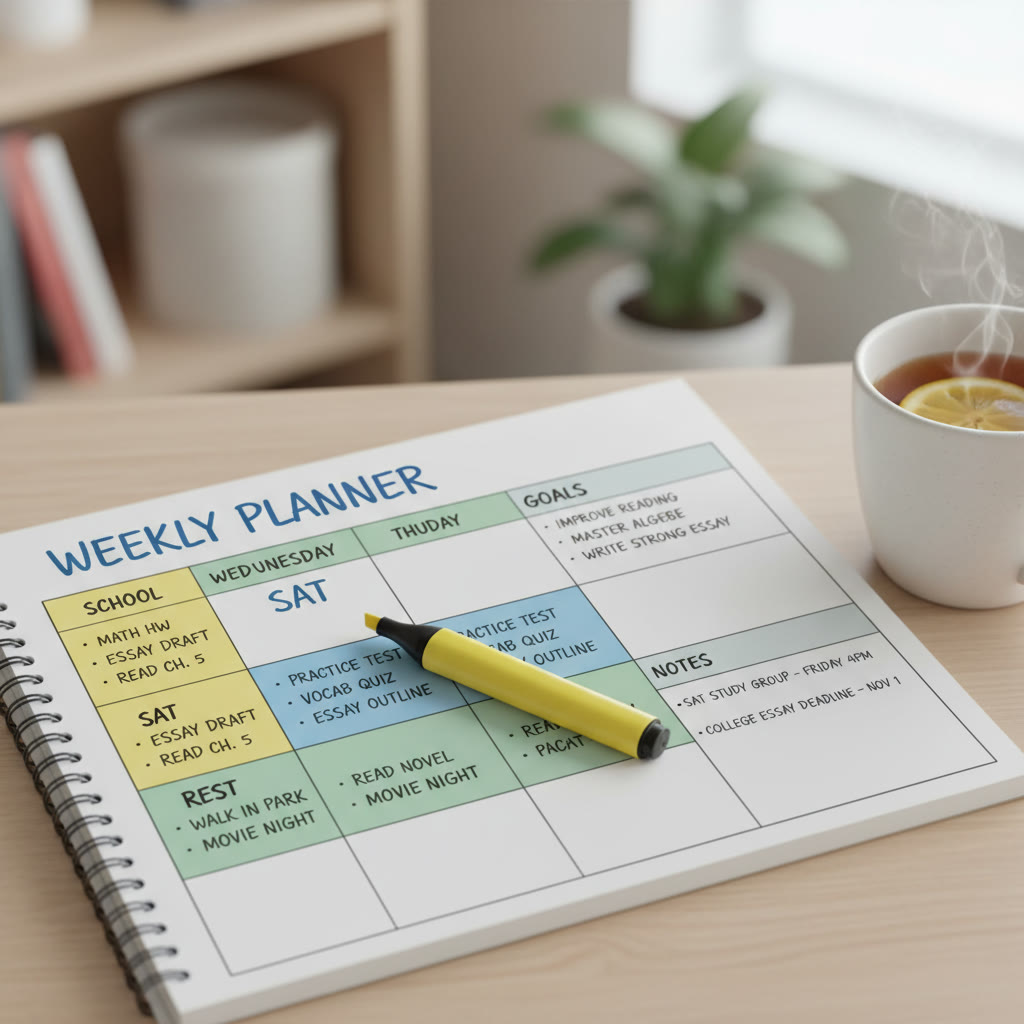Why balancing school and SAT prep isn’t optional—it’s essential
If youre juggling math homework, lab reports, extracurriculars, and the looming SAT, youre not alone. The pressure to excel in school and on standardized tests can feel like walking a tightrope. Spend too much time on SAT prep and your grades slip. Focus only on school and you risk missing the targeted practice that raises your test score. The sweet spot? Balance. When done thoughtfully, balancing schoolwork and SAT prep improves performance in both areas, keeps stress manageable, and helps you arrive on test day confident and clear-headed.

Why balance matters: more than just grades and scores
It might sound obvious that both classes and SAT matter, but the relationship between them is surprisingly synergistic. High school courses build the knowledge base the SAT tests, while efficient SAT practice sharpens test-taking speed and critical thinking that benefit classroom performance. Conversely, imbalance creates friction: obsessing over practice tests can drain energy for projects and labs, while all-school focus can leave you underprepared for the unique format and timing of the SAT.
Think of your academic life as a garden. School cultivates deep roots and steady growth; SAT prep is like targeted pruning and training that helps your strengths bloom at the right time. Neglect one and the whole garden suffers.
The cognitive case for balance
Research in learning science shows that varied, spaced practice yields better retention than intense cramming. Studying a little each day for two months beats one long all-night session before the test. When school and SAT prep are integrated into a manageable rhythm, your brain gets frequent retrieval practice—recalling information repeatedly over time—so knowledge moves from short-term to long-term memory. That means fewer panicked moments trying to remember grammar rules or algebra concepts during the test.
Emotional and physical reasons to keep the scales even
Burnout is real. Lack of sleep, skipped meals, and constant pressure reduce concentration, memory, and mood—exactly what you need for peak SAT performance. Balance protects mental health: built-in breaks, realistic practice goals, and reliable school performance help you maintain motivation. Students who balance well report less anxiety and better sustained productivity.
Common imbalances and their consequences
Understanding typical pitfalls helps you recognize when your own balance is off. Here are a few common scenarios and why they lead to trouble.
- All test prep, no class focus: You may improve on practice tests but risk missing class deadlines and losing GPA points that matter for college admissions.
- All-in on school, SATs on autopilot: If you rely solely on coursework, you might underperform on the SATs because format familiarity and timed practice are different skills.
- Cramped cram cycles: Cramming creates short-lived learning. It’s emotionally exhausting and often backfires on test day.
- Over-scheduling: Jamming every free hour with SAT drills can reduce focus and cause diminishing returns.
How to strike a smart balance—principles that work
Balance doesn’t mean a rigid equal split of hours; it means strategic allocation of time and energy so both school and SAT prep reinforce each other. Here are principles to guide you.
1. Prioritize based on calendar and likelihood
When big projects or exams are due in school, lean toward schoolwork for that week; it has immediate consequences. In quieter weeks, increase SAT practice. If your SAT date is close, ramp up targeted practice but keep critical class obligations covered. Your schedule should respond to what actually matters in the moment.
2. Use small, consistent blocks over marathon sessions
Short sessions (25–50 minutes) with breaks are more effective than 4-hour blocks that blur together. Consistency beats intensity: 30 minutes of focused SAT practice five days a week will change your scores more than a 10-hour marathon the night before.
3. Make schoolwork and SAT prep double-duty
Integrate your efforts. If youre studying algebra for class, use that time to also review algebra problems common on the SAT. When you read a history assignment, note evidence and argument structure—skills that help with SAT Reading and Writing. This overlap reduces total study time and makes both activities pay off.
Practical weekly routine with examples
Below is a sample weekly template that balances school and SAT prep for a student with after-school activities. It’s flexible—use it as a starting point and adapt to your deadlines, energy levels, and test date.
| Day | School (classes + homework) | SAT practice | Rest/Other |
|---|---|---|---|
| Monday | 3–4 hours: homework, review notes | 30–45 min: focused math problem set | Evening: 30 min unwind |
| Tuesday | 3–4 hours | 30 min: reading passages + review | Club practice |
| Wednesday | 3–4 hours | 45 min: timed section practice | Family time, sleep |
| Thursday | 3–4 hours | 30 min: grammar rules + error logs | Exercise |
| Friday | 2–3 hours | 60 min: practice test review (not full test) | Social time |
| Saturday | Light review | 1–2 hours: full-length sectional practice or diagnostics | Rest and hobbies |
| Sunday | Catch up on assignments | 30–60 min: error analysis and plan for next week | Prepare meals, reset |
This schedule assumes a test several months away. If youre within a month of the SAT, increase targeted practice while protecting sleep and key school deadlines. If you have six months, focus on steady skill-building and timed practice once a week.
Tools and techniques to make balance realistic
Good tools convert intention into action. The following techniques help you stay on track without burning out.
- Weekly planning session: Spend 20 minutes every Sunday to map the coming week. Identify high-priority school tasks and insert SAT blocks around them.
- Task batching: Group similar tasks (like reading or math homework) so you get into flow and finish faster.
- Error log: Keep a running list of mistakes you make on practice questions and classroom quizzes. Reviewing that list weekly is high-impact.
- Timed practice: Use short timed sections to practice pacing. Timing is a skill, and it responds to deliberate practice.
- Rest as strategy: Schedule sleep and downtime as non-negotiable. Your brain consolidates learning while you sleep.
Example: making homework count for SAT gains
Say your English teacher assigns an essay about social media’s effects. Use that assignment to sharpen the skills tested on SAT Writing: claim support, evidence integration, and clarity of expression. When your teacher grades the essay, note grammar and structure feedback in your SAT error log. Over time, classroom feedback becomes targeted SAT practice.
Measuring progress without panic
Students often obsess over every practice test score. Instead, use data thoughtfully. Track three numbers: accuracy trends, timing improvement, and error types. A small weekly improvement in these areas is more meaningful than a one-off big jump.
| Metric | Why it matters | How to track |
|---|---|---|
| Accuracy | Shows content mastery | Record percent correct per section |
| Timing | Indicates pacing skills | Note time left at checkpoint questions |
| Error patterns | Reveals underlying weaknesses | Maintain error log and review weekly |
Quarterly full-length practice tests are useful checkpoints. But don’t base your weekly mood on them. Instead, celebrate small wins: a week with fewer careless errors, consistent sleep, or a steady homework completion streak.
Real-world student cases: balance in action
Case 1: Maya, a junior with a demanding AP load, made a schedule that favored school during exam weeks and increased SAT work during lighter weeks. By integrating SAT problems into AP coursework and using her commute for flashcard review, she improved her score steadily without dropping in-class performance.
Case 2: Jamal prioritized SAT practice two months before his test but kept one focused night for school projects each week. When his English teacher gave a paper that week, he applied SAT grammar rules and earned a higher grade. His focused prep paid off without derailing his GPA.
Both students used strategies that emphasize flexibility, not a rigid split. They adjusted based on deadlines and energy, proving balance is dynamic, not fixed.
Where targeted help fits: how Sparkl’s personalized tutoring can support balance
Personalized tutoring is a great tool when used to complement, not replace, your schoolwork. Sparkl’s personalized tutoring offers 1-on-1 guidance, tailored study plans, expert tutors, and AI-driven insights that help you identify high-impact weaknesses quickly. That means less wasted time on low-return practice and more focused work where it counts.
For example, a Sparkl tutor can help you turn homework weaknesses into SAT gains: if your algebra homework reveals recurring mistakes, a tutor will show targeted strategies and practice that directly translate to SAT-style problems. The AI-driven insights can flag recurring grammar issues or pacing problems so your weekly plan becomes smarter, not longer.
Used sparingly and strategically, tutoring becomes a multiplier: it boosts efficiency, helps maintain school performance, and keeps your SAT plan aligned with real classroom demands.
Stress management: the overlooked piece
Balance includes emotional balance. Test anxiety and school stress are manageable with routine and perspective. Here are simple tools that students can use tonight.
- Breathing techniques: A 4-4-4 breath (inhale 4, hold 4, exhale 4) calms nervousness before a practice test.
- Micro-breaks: After every 45-minute study block, take a 10-minute walk or do light stretching to reset focus.
- Sleep hygiene: Aim for consistent bed and wake times. Even modest sleep gains improve concentration dramatically.
- Social check-ins: Talk through stress with a friend or family member—often the act of verbalizing reduces its power.
Action plan: a four-week sprint to better balance
If youre starting from a place of imbalance, try this four-week plan to build momentum.
- Week 1: Audit your current schedule. Track how you actually spend time each day. Identify two big time sinks and one quick change to reclaim 30–60 minutes daily.
- Week 2: Build a weekly template with 30–45 minute SAT blocks on three weekdays and one longer block on the weekend. Start an error log.
- Week 3: Add targeted practice based on error log trends. If grammar mistakes dominate, replace one math block with writing-focused work that week.
- Week 4: Take a timed sectional practice, analyze results, and tweak the schedule. Celebrate the wins—consistent study blocks, sleep, and completed assignments.
If you want more tailored feedback, a short series of 1-on-1 sessions with a tutor can compress months of progress into weeks by focusing only on what moves your score. Sparkl’s personalized tutoring can be a helpful addition in this sprint, offering tailored plans and insights that fit around your school calendar.
Final thoughts: balance is a skill you build
Balance between school and SAT prep isn’t a one-time setup. It’s a habit you cultivate through planning, honest assessment, and small daily choices. When you treat balance as a skill—one that responds to experimentation and refinement—you reduce stress, improve both grades and scores, and keep your life enjoyable along the way. Let your schoolwork and SAT prep work together: integrate tasks, measure what matters, and give yourself permission to rest. The result is not just a better SAT score, but a healthier, more sustainable path to college and beyond.

Next step
Pick one change from the four-week sprint and try it this week. Track how it affects your productivity and stress. Adjust, iterate, and remember: steady progress beats frantic effort. With the right plan and support—whether peers, teachers, or Sparkl’s personalized tutoring—you can find a balance that keeps your grades strong and your SAT score rising.
Good luck, and breathe—youve got this.











No Comments
Leave a comment Cancel